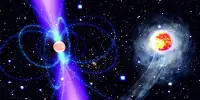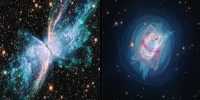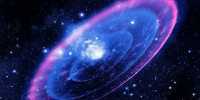Cosmic dust is created by stars and supernova, forming new structures of stars. The solar system is a dusty world, with billions of interstellar dust particles left behind by comets and asteroids orbiting the earth. Dust can be repeated in the lab, but the drying process can take days. All this dust forms a relatively thick cloud from which Earth flies, sweeping the interplanetary dust particles very efficiently. British scientists have demonstrated that a typical kitchen microwave oven can be used to make cosmic dust in the laboratory.
In addition to having significant knowledge of the atmospheres of other planets, these particles can have an effect on radio transmissions, environment and also function as fertilizers for phytoplankton in the oceans. Studying them will help answer questions like “Is there (or was there) extraterrestrial life?” “And how did life begin on Earth? “And unlock unexpected realistic alternatives to air travel.
A team of researchers has developed a new experimental Meteoric Ablation Simulator (MASI) that can help answer questions about cosmic dust and how it impacts Earth and everything on it.
A team of researchers at the University of Leeds in Great Britain headed by John Plane, professor of atmospheric chemistry, has created a new experimental Meteoric Ablation Simulator (MASI) that can help address questions about cosmic dust and how it affects Earth and everything.
While traces of interstellar dust have appeared on Earth in the form of interplanetary debris, comet dust, and meteorites, they are seldom representative. The properties of this substance can therefore be studied either by astronomical measurements or by simulated dust experiments developed in the laboratory. However, creating our very own cosmic dust on the Earth had previously been an expensive, complicated, and time-consuming process.

The study of the evaporation of interstellar dust particles in the upper atmosphere has, to date, relied heavily on statistical estimates. Proof provided by field radar and visual measurements of meteoroids is inconsistent in regards to the height from which any of the metals in the objects would degrade as they fall into the atmosphere. The Leeds model is the only model capable of simulating the evaporation of each major element (silicon, iron, magnesium, sodium, calcium) from interstellar dust particles. To place model equations on a solid experimental basis and to settle the question as to when each metal breaks down, the MASI was designed, where particles of a similar composition to cosmic dust are flash-heated to mimic atmospheric feedback while simultaneously tracking evaporating metals.
“Only relatively recent advances in computing hardware and software have allowed us to address the precise timing and substantial computational requirements needed for MASI,” said David Bones, a member of the Leeds research team working on the project. “During a particle entry simulation that lasts about 12 seconds, we want to take 6,000 measurements while we are rapidly changing the temperature of the filament to flash-heat the particle with real-time feedback.”
The Meteoric Ablation Simulator is the first ablation experiment capable of simulating precise mass, velocity, and angle-specific temperature profiles while simultaneously monitoring the resulting gas phase ablation products. This results in elemental atmospheric inputs that consider the mass and size distribution of interplanetary dust particles.
So what are we learning from MASI?
Although the measurements for sodium and iron ablation were relatively well matched with the formula, the measurements of calcium ablation did not suggest that we need a more complex ablation model that can take into account considerations such as the particles breaking up into smaller parts in the atmosphere and the fact that these particles are not identical in composition but are aggregates of different forms.
Perhaps unexpectedly, the understanding of interplanetary dust particles and the use of instruments such as the Meteoric Ablation Simulator have more than apparent significance. In addition to having a deeper view of the upper atmosphere and the metal layers found there, the simulator provides other methods for understanding the creation of planets from industrial applications.
“The jet turbines are an example of an area where small particles can be heated quickly,” Bones said. “By better understanding the melting and ablation processes, we can design ash-resistant jet engines that could fly through an ash cloud like the one created when the Eyjafjallajökull volcano erupted in 2010.”














